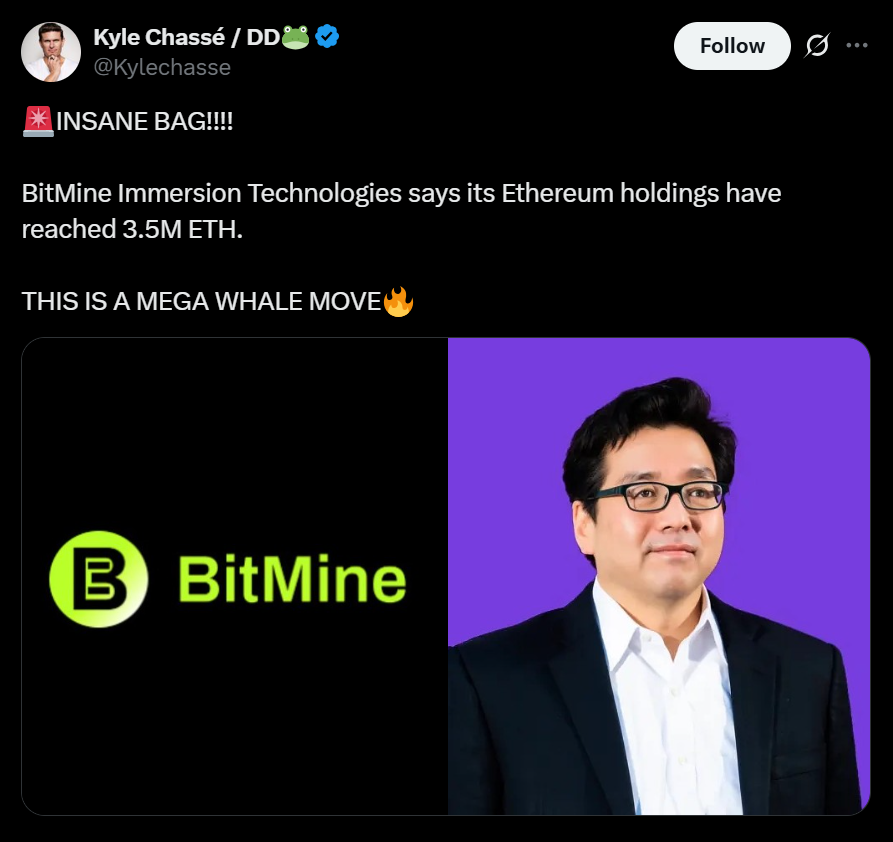- BitMine has accumulated 3.5M ETH — about 2.9% of supply — making it the largest corporate Ethereum holder, alongside smaller BTC and equity positions.
- The company has been buying aggressively into price weakness, creating unrealized losses while following a treasury playbook similar to Strategy Inc’s bitcoin strategy.
- Investors are criticizing BitMine for keeping its ETH unstaked and demanding clearer on-chain transparency, even as the firm targets 5% of total ETH and leans into a long-term tokenization thesis.
BitMine Immersion Technologies has quietly turned itself into the world’s largest corporate holder of Ethereum, disclosing that its treasury reached 3,505,723 ETH as of Nov. 9 at 8 p.m. ET. That stash represents roughly 2.9% of Ethereum’s 120.69 million circulating supply, a concentration that effectively makes BitMine a systemic player in the ETH ecosystem whether people like it or not.
Alongside its Ethereum stack, the company’s balance sheet includes about $398 million in liquid funds, 192 Bitcoin and a $61 million equity position in Eightco Holdings. With ETH trading near $3,537 and 24-hour volatility hovering around 0.2%, BitMine’s bet is very much a macro-size call on Ethereum’s role in the future of finance, not just a short-term trade.

BitMine’s shares have become extremely liquid as well. Over the five trading sessions through Nov. 7, the stock averaged about $1.6 billion in daily dollar volume, ranking 48th among all U.S.-listed equities, sitting between Lam Research and Arista Networks. For a digital asset treasury play, that’s rarefied company.
Aggressive Accumulation Amid Price Weakness
BitMine isn’t just sitting on an old pile of ETH — it’s been aggressively adding during a choppy market. Over the seven days ending Nov. 10, the firm secured 110,288 ETH, a 34% jump from the prior week’s 82,353-token haul.
Chairman Tom Lee, who also founded Fundstrat, framed the recent moves as opportunistic rather than reckless. He’s described current ETH price levels as “favorable conditions” for expanding the company’s position, effectively treating pullbacks as bulk discount events.
The timing hasn’t been kind in the short term, though. The Nov. 3 purchase of 82,353 ETH came with prices near $3,903, and the Nov. 10 batch landed around $3,639. With ETH now trading closer to $3,537, both tranches are sitting on unrealized losses.
This accumulation has taken place against a pretty hostile backdrop: outflows from digital investment products reached about $1.17 billion over the past week, and previous buying coincided with turbulence triggered by a DeFi protocol security breach. In other words, BitMine is adding risk while a lot of institutional money is backing away.
Following Strategy Inc’s Treasury Playbook
BitMine’s strategy closely mirrors the one pioneered by Strategy Inc, the company that turned itself into a de facto bitcoin ETF by stacking BTC on its balance sheet. Strategy still holds the crown for largest corporate crypto treasury overall, with roughly 641,205 BTC worth about $67 billion at current prices.
BitMine has essentially taken the same playbook and applied it to Ethereum. Together, BitMine and Strategy now account for roughly 88% of trading volume across all digital asset treasury stocks, making them the two core vehicles for public-equity exposure to large crypto treasuries.
Strategy has even gone as far as launching a euro-based equity offering to fund additional bitcoin purchases. BitMine’s version of that story is the “alchemy of 5%” — Tom Lee’s framework for eventually targeting 5% of Ethereum’s total circulation under corporate control.

Staking Snub Sparks Investor Frustration
There’s a catch to BitMine’s big ETH stack: none of it is staked, and shareholders are starting to ask loud questions about that choice.
On-chain tracking hasn’t entirely lined up with the company’s disclosures either. Arkham Intelligence currently monitors about 3.232 million ETH across wallets it has verified as belonging to BitMine, while The Block’s monitoring system shows closer to 2.83 million tokens. Both totals fall short of the 3.505 million figure BitMine reports publicly, prompting some investors to push for clearer, more frequent transparency on wallet structures and net asset value.
Meanwhile, SharpLink Gaming, which holds the second-largest corporate ETH position, has taken the opposite approach: it stakes its entire Ethereum treasury and recently committed to deploying $200 million through Linea, layering staking and restaking strategies to maximize yield.
That comparison isn’t flattering for BitMine. With Ethereum now firmly in a proof-of-stake world, keeping such a large treasury completely unstaked looks like a deliberate, high-conviction bet on flexibility over yield — but it also means forgoing substantial staking income that could cushion volatility or offset unrealized losses. Investors are pressing the company to explain why it isn’t matching the disclosure and yield standards other treasury operators are starting to set.
Long-Term Ethereum Thesis Despite Near-Term Pain
Despite the short-term drawdown and the criticism, BitMine is doubling down on its long-term Ethereum thesis. On Nov. 6, BitMine and the Ethereum Foundation co-hosted a financial services summit at the New York Stock Exchange, an optics-heavy moment designed to underline Ethereum’s role in institutional-grade finance, not just speculative trading.
Tom Lee used the event to highlight what he calls strong institutional appetite for asset tokenization — the idea that everything from bonds to real estate to private funds will eventually exist as programmable tokens on blockchains like Ethereum. From BitMine’s perspective, that future easily outweighs a few hundred dollars’ worth of downside per coin in the near term.
The company’s stated target of 5% of all ETH in circulation won’t be easy to reach and comes with real concentration risk. But BitMine is essentially making a very public, very large statement: if Ethereum is the base layer of tokenized finance, then owning a giant slice of its supply is the kind of exposure they want, even if it means sitting through ugly weeks of outflows and red candles.














